Abstract
The proposition that tropical forest swidden gardens mimic the extraordinary species diversity of the forest by the use of extensive intercropping is examined in the light of the field architecture of the Barí, a people of the Maracaibo basin. Barí fields manifest annular zonation rather than intercropping. It is concluded that Barí horticulture is an inversion of the jungle rather than an imitation of it.
Similar content being viewed by others
References
Beckerman, S. (1980). Fishing and hunting among the Barí of Colombia.Working Papers in South American Indians 2: 67–109.
Bergman, R. (1980).Amazon Economics: The Simplicity of Shipibo Indian Wealth. University Microfilms, Ann Arbor.
Denevan, W. (1971). Campa subsistence in the Gran Pajonal, Eastern Peru.The Geographical Review 61: 496–518.
Geertz, C. (1963).Agricultural Involution: The Processes of Ecological Change in Indonesia. University of California Press, Berkeley.
Harris, D. (1971). The ecology of swidden cultivation in the Upper Orinoco Rain Forest, Venezuela.The Geographical Review 61: 475–495.
Jaulin, R. (1970).La Paix Blanche: Introduction a I'Ethnocide. Éditions du Seuil. Paris.
Kass, D. C. (1978). Polyculture cropping systems: Review and analysis.Cornell International Agriculture Bulletin 32: 1–68.
Lizarralde, R., and Beckerman, S. (in press). Impact of colonization on Bari settlement patterns and culture in Colombia and Venezuela. In Stark, L., and McDonald, T. (eds.),Amazonia: Extinction or Survival?, University of Wisconsin Press, Madison.
Montaldo, A. (1973). Importancia de la yuca en el mundo actual con especial referenda a Venezuela.Revista de la Facultad de Agronomia de la Universidad Central de Venezuela 22: 17–40.
Pielou, E. (1969).An Introduction to Mathematical Ecology. Wiley-Interscience, New York.
Pinton, S. (1965). La maison Bari.Journal de la Societe des Americanistes 54: 247–333.
Smole, W. (1976).The Yanomama Indians: A Cultural Geography. University of Texas Press, Austin.
Stelly, M. (ed.) (1976). Multiple cropping.American Society of Agronomy Special Publication 27, Madison, Wisconsin.
Stocks, A. (1983). Candoshi and Cocamilla swiddens in eastern Peru.Human Ecology 11(1). 69–84.
Tergas, L. E., and Popenoe, H. L. (1971). Young secondary vegetation and soil interactions in Izabal, Guatemala.Plant and Soil 34: 675–90.
von Loesecke, H. (1949).Bananas, 2nd ed. Interscience Publishers, New York.
Willey, R. W. (1979). Intercropping -its importance and research needs.Field Crop Abstracts 32: 1–10; 73–85.
Author information
Authors and Affiliations
Additional information
This article is based on a paper given at a symposium entitled “Does the Swidden Ape the Jungle?” held at the December 1980 Annual Meeting of the American Anthropological Association in Washington, D.C.
Rights and permissions
About this article
Cite this article
Beckerman, S. Barí Swidden gardens: Crop Segregation patterns. Hum Ecol 11, 85–101 (1983). https://doi.org/10.1007/BF00891232
Issue Date:
DOI: https://doi.org/10.1007/BF00891232




